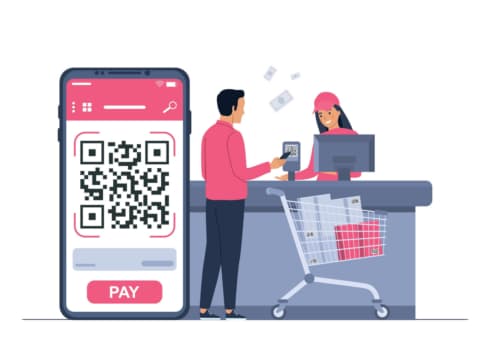The concept of "proximity payments" in India encompasses various technologies like NFC, sound-based solutions and QR
The rise of proximity payments is being driven by both consumer demand and merchant adoption
Omnichannel retail reinvention in India is accelerating as major companies enable mobile payments across all consumer touchpoints
Inc42 Daily Brief
Stay Ahead With Daily News & Analysis on India’s Tech & Startup Economy
Proximity payments, which allow shoppers to tap or wave their phone or wearable device to make a payment, are revolutionising retail. Once viewed as a novelty, proximity payments are now becoming a core component of seamless omnichannel retail strategies. India is witnessing a proximity payment revolution of its own.
The concept of “proximity payments” in our country encompasses various technologies like NFC, sound-based solutions and QR. The government has been aggressively pushing digital payments, resulting in ubiquitous QR code adoption at small vendors and QR-based apps achieving massive scale.
India is now home to one of the largest QR ecosystems globally. Recognising the evolving landscape, Apple strategically introduced Apple Pay in the country in 2022, seamlessly integrating with India’s indigenous RuPay card network. Despite the growing prevalence of QR codes, the overall user experience has been less than optimal, prompting a demand for more user-friendly proximity technologies such as Sound and NFC.
Concurrently, the surge in payroll cards is empowering underbanked consumers to engage in mobile tap-to-pay transactions. The adoption of innovative applications tailored for India, including tap-based transit payments, is experiencing swift growth. Fueled by extensive smartphone usage and widespread merchant readiness, the populace is enthusiastically embracing phone-based checkouts, highlighting the need for enhanced experiences through advanced proximity technologies like Sound and NFC.
Rise Of Proximity Payments In India
Widely considered one of the most successful payment systems in the world, the launch of UPI Payments is where it all started. The Unified Payments Interface (UPI) reached 10 Bn transactions in August 2023, marking a watershed milestone in the country’s digital payments narrative. To put this in perspective, that is about 2 Bn greater than the whole global population! Adding to this success, UPI is now prioritising user convenience through initiatives like Hello UPI, offering customers more straightforward and convenient payment options.
For a country where even a small transaction of INR 10 can be done through UPI whether it is a giant retail store or local vegetable seller, proximity payments seem like a natural progression. The rise of proximity payments is being driven by both consumer demand and merchant adoption. Shoppers increasingly expect checkout to be fast and frictionless. Tapping a credit card, scanning a smartphone, or employing voice commands for conversational check-outs is perceived as more convenient than grappling with cash or even inserting a chip-based card. Major providers such as Apple Pay, Google Pay, and Samsung Pay have made substantial investments in marketing and the development of robust ecosystems.
For retailers, proximity payments provide quantifiable benefits beyond just customer convenience. Studies show that proximity payment users spend more per transaction compared to other tender types. The data-rich nature of mobile wallets also gives merchants deeper insights into customer preferences and behaviours. Proximity payments are also vulnerable to less fraud than alternatives, given their encrypted tokenisation technology.
New Omnichannel Retail Strategies Benefiting From Proximity Payments
Omnichannel retail reinvention in India is accelerating as major companies enable mobile payments across all consumer touchpoints. Large fast-moving consumer goods brands have added checkout via QR codes on their direct-to-home websites with pilots for similar functionality across their distribution reaching rural storefronts. Restaurant chains have rolled out scan-and-pay features within native apps allowing food ordering and tap-to-pay in-store pickups in a consistent brand experience. Global retailers like Amazon will soon allow checkout in their brick-and-mortar stores via scanning mobile apps, as successfully pioneered in Western stores.
The future of proximity payments in India looks promising with its unique combination of youthful demographics, solving for small-ticket use cases and decentralised network scaling. Simply put, organised chains and local stores enabling mobile checkout remove the last physical barrier to native digital retail.
In the next few years, creative merchants and startups will make proximity payments the connective thread across diverse retail models. Brick-and-mortar stores, quick commerce via bike delivery, ordering online for in-store pickups and other emerging channels can all plug into a common mobile payment acceptance back-end. Additional experiments around mini-consumer apps living within popular payment apps will emerge.
The Road Ahead
Just a couple of years ago, plastic card acceptance in stores was limited largely to cities and high-value purchases. However, the success of various digital payment technologies, such as NFC (Near Field Communication), Sound (Audio frequency), RFID (Radio-Frequency Identification), and mobile wallet solutions (e.g., Apple Pay, Google Pay), has outlined a practical roadmap for the Indian economy to transition into a cashless era. Tapping fits perfectly with younger Indian consumers transacting seamlessly from mobile.
Frictionless checking out via phones enhances loyalty while unlocking experience and format innovation across the Indian shopping landscape. As companies embrace diverse technologies that offer improved security, speed, and user convenience and move away from QR codes, this evolution is reshaping the trajectory of digital transactions in the country, offering a more dynamic and secure landscape for cashless transactions.
{{#name}}{{name}}{{/name}}{{^name}}-{{/name}}
{{#description}}{{description}}...{{/description}}{{^description}}-{{/description}}
Note: We at Inc42 take our ethics very seriously. More information about it can be found here.


